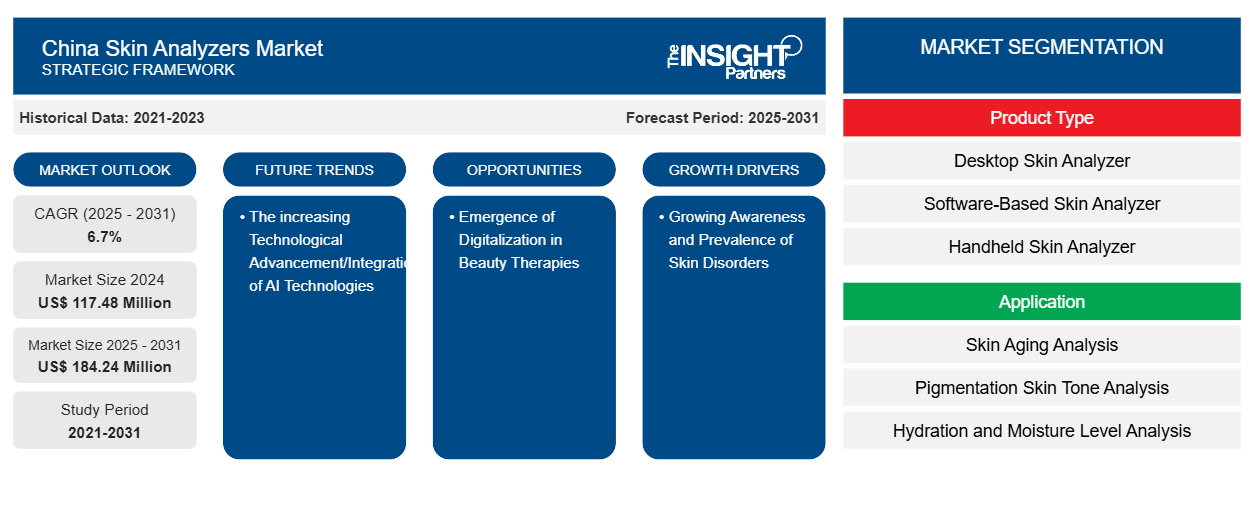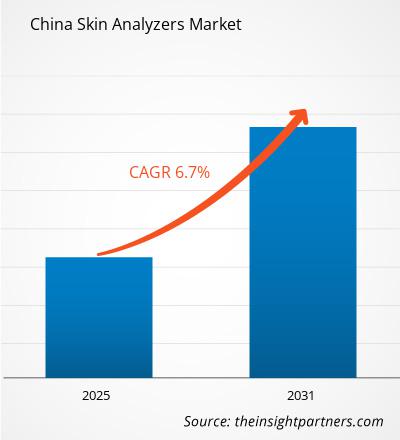中国皮肤分析仪市场规模预计将从2024年的1.1748亿美元增至2031年的1.8424亿美元。预计2025年至2031年期间,该市场的复合年增长率将达到6.7%。人工智能技术的不断进步和融合,可能会在未来几年为市场带来新的趋势。
中国皮肤分析仪市场分析
皮肤分析仪用于分析皮肤的各种参数,例如细纹、皱纹、水分含量、紫外线损伤等。这有助于确定最佳的护肤产品和方案,并帮助肌肤健康亮丽。推动市场增长的主要因素包括人们对皮肤病的认识和患病率的提高,以及护肤个性化需求的激增。此外,产品开发和上市的增加预计将促进市场增长。此外,美容疗法数字化的兴起预计将为未来几年的市场增长创造充足的机会。
中国皮肤分析仪市场概况
受科技进步和个性化护肤理念日益提升的推动,中国皮肤分析仪市场正经历显著增长。这一增长主要源于皮肤科诊所、美容院以及个人消费者对皮肤分析仪的日益普及。美测等市场主要参与者通过提供一系列皮肤分析工具,包括ISEMECO 3D D9皮肤分析仪和MEICET PRO-A皮肤成像分析仪,为这一市场扩张做出了贡献。这些设备采用人工智能 (AI) 和机器学习等先进技术,可提供详细的皮肤评估,预测未来的皮肤状况,并推荐个性化的护肤方案。人工智能的集成显著提升了这些分析仪的准确性和功能性,使其成为专业领域和个人用途的宝贵资产。
中国中产阶级人口不断增长,加上可支配收入的提高,导致对高端护肤产品和工具的需求不断增长。这一趋势,加上技术创新和个性化护肤的趋势,预计将推动中国皮肤分析仪市场的增长。
定制此报告以满足您的要求
您可以免费定制任何报告,包括本报告的部分内容、国家级分析、Excel 数据包,以及为初创企业和大学提供优惠和折扣
中国皮肤分析仪市场:战略洞察

- 获取此报告的顶级关键市场趋势。此免费样品将包括数据分析,从市场趋势到估计和预测。
中国皮肤分析仪市场驱动因素和机遇
皮肤病意识的提高和患病率的上升推动了中国皮肤分析仪市场的发展
中国皮肤病发病率急剧上升。《儿童变态反应与免疫学》杂志报道,特应性皮炎(AD)是所有皮肤病中疾病负担最高的。中国AD患病率最高的是5岁以下儿童(每10万人3455.56人),5-9岁儿童(每10万人3360.31人)。预计2030年AD年龄标准化患病率男性为1394.36人(每10万人),女性为1603.69人(每10万人)。中国是继美国和印度之后,全球第三大银屑病发病国,共有230万成年人患有银屑病。痤疮影响着全球约9.4%的人口,一项荟萃分析显示中国的痤疮发病率为39.2%,青少年群体的发病率明显更高。皮肤病发病率的上升导致了对诊断设备(例如皮肤分析仪)的需求增加,这些设备用于监测和控制这些疾病。皮肤病负担不断上升,皮肤病在全国发病率中排名第九,凸显了对新型先进诊断技术的需求。中国皮肤病发病率的增长有力地推动了皮肤分析仪市场的发展,医疗保健提供者和消费者都在寻求有效的早期诊断和控制方法。
美容疗法数字化的兴起创造增长机会
美容护理领域数字化的快速发展为创新和拓展提供了巨大的机遇。将人工智能和机器学习等尖端技术融入皮肤分析,将彻底改变皮肤护理。例如,欧莱雅和玉兰油研发了基于人工智能的皮肤分析仪,可以评估皮肤健康状况并推荐个性化的护肤方案。这些技术采用高分辨率成像和数据分析技术,提供精准的皮肤健康测量数据。此外,美图秀秀等新兴应用程序也使这些技术触手可及,消费者能够在智能手机上进行实时皮肤分析。因此,预计在预测期内,美容护理领域新兴的数字化和技术进步将为市场带来丰厚的利润。digitalization in L'Oréal and Olay have created AI-based skin analyzers that evaluate skin health and suggest customized skincare regimens. These technologies employ high-resolution imaging and data analysis to deliver accurate skin health measurements. Additionally, emerging apps such as Meitu have made these technologies accessible, enabling consumers to perform real-time skin analysis on their smartphones. Therefore, the emerging digitalization and technological advancements in beauty treatments are expected to offer lucrative opportunities to the market during the forecast period.
中国皮肤分析仪市场报告细分分析
有助于得出中国皮肤分析仪市场分析的关键部分是产品类型、应用、光谱类型和最终用户。
- 就产品类型而言,中国皮肤分析仪市场分为台式皮肤分析仪、基于软件的皮肤分析仪和手持式皮肤分析仪。台式皮肤分析仪在2024年占据了最大的市场份额。
- 根据应用,市场细分为皮肤老化分析、色素沉着和肤色分析、水润度和湿度分析、皱纹和毛孔分析、紫外线损伤检测等。2024年,皮肤老化分析领域占据市场主导地位。
- 根据频谱类型,市场分为实时频谱分析仪和扫频调谐频谱分析仪。实时频谱分析仪在2024年占据了更大的市场份额。
- 根据最终用户,市场分为皮肤科诊所、美容诊所、家庭用户和研究机构。2024年,皮肤科诊所占据了市场主导地位。
中国皮肤分析仪市场份额分析
随着皮肤病发病率的不断上升、皮肤成像设备的飞速发展以及消费者对护肤的日益重视,中国皮肤分析仪市场正在显著增长。此外,消费者美容意识的增强和可支配收入的大幅增长也促进了市场的增长。此外,国内外市场参与者的不断壮大预计将推动中国皮肤分析仪设备的种类不断丰富。
中国皮肤分析仪市场区域洞察
Insight Partners 的分析师已详尽阐述了预测期内影响中国皮肤分析仪市场的区域趋势和因素。本节还讨论了中国皮肤分析仪市场在北美、欧洲、亚太地区、中东和非洲以及南美和中美洲的细分市场和地域分布。

- 获取中国皮肤分析仪市场的区域特定数据
中国皮肤分析仪市场报告范围
| 报告属性 | 细节 |
|---|---|
| 2024年的市场规模 | 1.1748亿美元 |
| 2031年的市场规模 | 1.8424亿美元 |
| 全球复合年增长率(2025-2031) | 6.7% |
| 史料 | 2021-2023 |
| 预测期 | 2025-2031 |
| 涵盖的领域 | 按产品类型
|
| 覆盖地区和国家 | 中国
|
| 市场领导者和主要公司简介 |
|
中国皮肤分析仪市场参与者密度:了解其对业务动态的影响
中国皮肤分析仪市场正在快速增长,这得益于终端用户需求的不断增长,而这些需求的驱动因素包括消费者偏好的不断变化、技术进步以及对产品优势的认知度不断提高。随着需求的增长,企业正在扩展产品线,不断创新以满足消费者需求,并抓住新兴趋势,从而进一步推动市场增长。
市场参与者密度是指特定市场或行业内企业或公司的分布情况。它表明特定市场空间内竞争对手(市场参与者)的数量相对于其规模或总市值而言。
在中国皮肤分析仪市场运营的主要公司有:
- 北京科埃斯生物科技有限公司
- 山东华美科技有限公司
- 北京宏康科技有限公司
- 北京新科仁科技发展有限公司
- 广州仁朗电子科技有限公司
- 欧莱雅公司
免责声明:以上列出的公司没有按照任何特定顺序排列。

- 获取中国皮肤分析仪市场主要参与者的概述
中国皮肤分析仪市场报告覆盖范围及成果
《中国皮肤分析仪市场规模及预测(2021-2031)》报告对以下领域进行了详细的市场分析:
- 中国皮肤分析仪市场规模及涵盖范围内所有主要细分市场的预测
- 中国皮肤分析仪市场趋势以及市场动态,如驱动因素、限制因素和关键机遇
- 详细的 PEST 和 SWOT 分析
- 中国皮肤分析仪市场分析涵盖关键市场趋势、国家框架、主要参与者、法规和最新市场发展
- 行业格局和竞争分析,包括市场集中度、热图分析、知名企业以及中国皮肤分析仪市场的最新发展
- 详细的公司简介
- 历史分析(2 年)、基准年、预测(7 年)及复合年增长率
- PEST和SWOT分析
- 市场规模、价值/数量 - 全球、区域、国家
- 行业和竞争格局
- Excel 数据集
近期报告
客户评价
购买理由
- 明智的决策
- 了解市场动态
- 竞争分析
- 客户洞察
- 市场预测
- 风险规避
- 战略规划
- 投资论证
- 识别新兴市场
- 优化营销策略
- 提升运营效率
- 顺应监管趋势




















 获取免费样品 - 中国皮肤分析仪市场
获取免费样品 - 中国皮肤分析仪市场